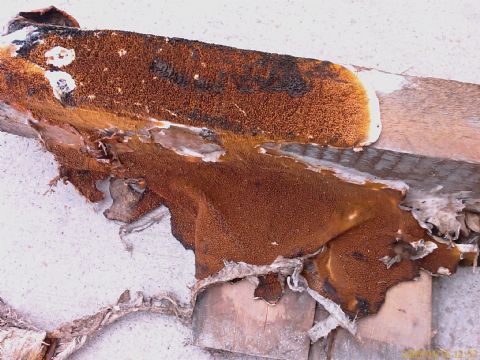We are Experts in Dry rot identification, treatment, timber replacement and repair. We cover Leeds, Harrogate, Wakefield, Bradford & surrounding areas.
We offer services to trade, commercial and domestic clients so whether you require timber treatment only or replacement and treatment we are able to help!
What is Dry Rot?
Dry Rot is the common name for a particular species of wood rotting fungi – Serpula Lacrymans.
Wood rotting fungi that are found in buildings can be split into 2 groups – White Rots & Brown Rots. These groups are named after the rots effect on the wood it is decaying.
Dry Rot is a Brown Rot. Brown rots cause the wood to darken. As the wood rots, cracks will appear across the grain. Well rotted wood will crumble to dust when dry.
What causes Dry Rot?
The ingredients for rot to take hold are:-
Excluding any one of these from the ‘mix’ prevents rot from occurring. In properties there are many timbers and spores everywhere; this leaves the one controllable ingredient as water. Unfortunately, we place many timbers in areas of buildings where they are susceptible to moisture ingress. This is particularly so in ground floors, roofs and in areas where we use water, such as bathrooms and kitchens. Any timbers that come in prolonged contact with water will eventually rot.
An aggressive fungal attack, dry rot always starts in wet timbers but can continue to grow with a restricted moisture supply, spreading extensively through masonry to attack any timbers it meets.
Severe structural damage to timbers in buildings can result and specialist treatments are always required.
Assessment
Like assessing insect attack to timbers, our work to deal with timber rot always starts with a visit to site to inspect the problem. Testing usually involves the probing of potentially affected timbers with a sharp screwdriver and visual identification of any fungal growths. Any “give” in the timbers indicates softening usually caused by fungal decay. In well-decayed timbers, a screwdriver can be driven into the rotten timber core, or sections of timber easily split away from the timber’s surface. Treatment depends on the rot type, its location and the structural requirements of the remedial repairs. The initial treatment must always allow for the exclusion of water from the timber or the isolation of the timber from further moisture source with a physical barrier. Chemical treatments are employed to help new timbers or remaining timbers withstand levels of residual moisture, which otherwise might continue to allow further decay.
Treatment
Use of fungicidal treatments is governed by Acts of Parliament (law) and Health and Safety Regulations. This requires specialist knowledge. Timber replacement must follow existing Building Regulations and guidelines to make sure that the timbers can perform structurally to specification.
Where treatment is recommended/required, then this is usually a combination of liquid and paste or gel compounds of boron (a naturally occurring mineral). We also sometimes use a fungicidal micro-emulsifiable solution (FMEC), otherwise known as polyphase or iodo-propynyl butyl carbamate, where circumstances allow or dictate. However, most of the treatments we carry out are with boron, which is a natural fungicide in the right concentration.
Repairing and preventing dry rot is not always straightforward as it may involve the extensive rebuilding of structural building components. Chemical control treatments may support environmental improvements. Caution should be taken after chemical treatments as there is usually a period of time a treated area cannot be re-occupied until treated surfaces have dried. Drying out is unlikely to be that fast unless it is forced.
Recent reformulation of timber treatment fluids now means that they are virtually odour free. Some slight smell may be noticed immediately after treatment, but this quickly declines with drying and improved ventilation.


